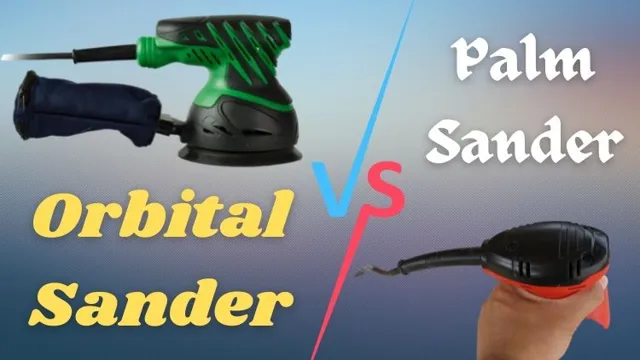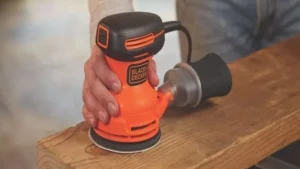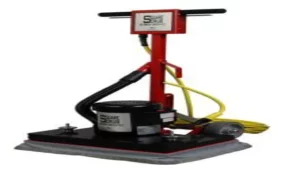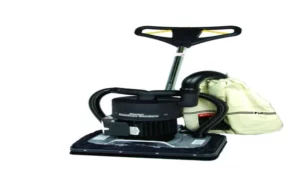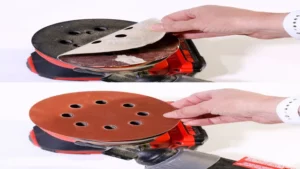If you’re looking for a sander to finish off your woodworking project, you may be wondering what the difference is between a palm sander and an orbital sander. Both are efficient tools that can help you achieve a smooth, polished finish, but which one is better? Well, let’s start with the basics. A palm sander, as the name suggests, is a smaller, handheld tool that is great for getting into tight spaces.
It uses a square or rectangular sandpaper pad that vibrates in small orbits to smooth surfaces. On the other hand, an orbital sander has a circular sandpaper pad that spins in a circular motion to sand surfaces. So, which one should you choose? The answer ultimately depends on the type of project you’re working on.
Palm sanders are ideal for less demanding projects that require a smaller surface area to be sanded, while orbital sanders are better suited for larger projects that involve sanding a larger surface. Additionally, palm sanders are often more affordable and easier to maneuver, making them a great option for beginners or those who prefer a lightweight tool. Whereas, an orbital sander may be more expensive and can require a bit more skill to operate efficiently.
In the end, the decision between a palm sander and orbital sander comes down to your personal preferences and the needs of your project. As with any tool selection, it’s important to consider the scope of your project, your skill level, and your budget to pick the sander that best fits your needs.
Overview
When it comes to sanding, two of the most popular options are palm sanders and orbital sanders. But which one is better? The truth is, it depends on what you’re using it for. Palm sanders are smaller and easier to maneuver, making them great for smaller projects or tight spaces.
They also tend to be less expensive than orbital sanders. However, if you have a larger project or want a smoother, more even finish, an orbital sander might be the better choice. They use a circular motion to sand, which helps prevent uneven patches.
They also tend to produce less dust, which can be a big plus. Ultimately, the choice between the two will come down to your personal preferences and the specific project you’re working on.
Description of palm sander and orbital sander
When it comes to sanding, there are two main types of sanders: palm sanders and orbital sanders. Palm sanders are compact, handheld sanders that are perfect for smoothing out small pieces of wood or removing paint or varnish. They typically feature a square pad that oscillates back and forth, making quick work of any sanding task.
On the other hand, orbital sanders are larger, more powerful machines that are designed for sanding larger surfaces like floors or large pieces of wood. They feature a circular pad that spins in a circular motion, making it easy to remove even the toughest blemishes. While both types of sanders can be incredibly useful, the type you choose will largely depend on the task at hand and your personal preference.
Whether you opt for a palm sander or an orbital sander, you can rest assured that you’ll be able to achieve a smooth, even finish on any project.
Pros and cons of palm sander and orbital sander
When it comes to sanding, two of the most popular types of sanders are palm sanders and orbital sanders. Each has its own advantages and disadvantages, and the decision of which to use ultimately depends on the project at hand. Palm sanders are known for their compact size and ease of use, making them a popular choice for DIY enthusiasts.
They are great for sanding small areas and tight spaces, but they may not be as effective for larger surfaces. Orbital sanders, on the other hand, are designed for larger areas, and their random orbital action helps to prevent swirl marks. However, they may be more difficult to handle and can be more expensive than palm sanders.
Overall, it’s important to consider the size of the project, the type of material you are working with, and your own personal preferences when choosing between these two types of sanders.
Uses
If you’re debating between using a palm sander or an orbital sander for your project, it ultimately depends on the task at hand. Both sanders serve different purposes and have their unique pros and cons. A palm sander is smaller and easier to maneuver, perfect for sanding smaller surfaces and getting into tight spaces.
On the other hand, an orbital sander is larger and more powerful, making it ideal for sanding larger surfaces and removing more material. Additionally, an orbital sander is more efficient and tends to leave a smoother finish, reducing the amount of time needed for finishing touches. Ultimately, it’s best to consider the project and determine which sander will provide the best results for your specific needs.
Palm sander use cases and benefits
Palm sanders are versatile tools that come in handy for several tasks. One of the most common uses of a palm sander is sanding flat surfaces such as tabletops, wood floors, and doors. It’s an ideal tool for removing paint, smoothing rough surfaces, and preparing surfaces for a new coat of paint or finish.
Additionally, palm sanders are perfect for sanding tight spaces and curves that are difficult to reach with other sanders. They can be used to sand intricate details on furniture, carvings, and cabinetry. Another use of a palm sander is to shape and contour wood pieces.
One of the benefits of using a palm sander is that it saves time and provides a more even surface than sanding by hand. Keyword: Palm sander.
Orbital sander use cases and benefits
Orbital sanders have a wide range of uses and benefits that make them valuable tools for any DIY or professional project. One of the most common uses of an orbital sander is for surface preparation, whether it’s for painting or for refinishing furniture. Orbital sanders excel at removing imperfections on surfaces, including paint or stains, and making them smoother for the next step in the project.
Another use case is for polishing materials like metal or acrylics, as they can easily create a smooth, even surface with minimal effort. They’re also great for sanding tight spaces and corners, making them perfect for complex woodworking projects. Additionally, using an orbital sander is less tiring than using traditional sandpaper, as it requires less physical effort.
Overall, orbital sanders are versatile and user-friendly tools that provide great results in a range of projects.
Features
If you’re trying to decide which sander is better for your next project, it’s important to understand the differences between a palm sander and an orbital sander. While both tools serve a similar purpose, they have several key features that set them apart. A palm sander is typically smaller and lighter than an orbital sander, which makes it easier to maneuver in tight spaces.
However, an orbital sander is more powerful and efficient when it comes to removing material quickly. Additionally, an orbital sander has a rectangular sanding pad that is better for sanding large, flat surfaces, while a palm sander is better suited for sanding curves and contours. Ultimately, the choice between the two will depend on your specific needs and preferences.
Palm sander features and functionalities
When it comes to palm sanders, there are a few key features to look out for. Firstly, you want to ensure that the sander has a good dust collection system, as sanding can be a messy task. Look for a sander with a dust bag or a feature that allows you to connect it to a vacuum cleaner.
Another important feature is variable speed. This allows you to adjust the speed of the sander according to the task at hand, giving you greater control and precision. Additionally, a comfortable grip is crucial, especially if you will be working on larger projects for an extended period of time.
Some palm sanders come with an ergonomic grip or additional padding to reduce hand fatigue. Finally, consider the size and shape of the sanding pad. A larger pad will cover more surface area, but it may be less precise in tighter spaces.
A smaller pad can reach tight corners and angles but may take longer to sand large surfaces. With these features in mind, you can find a palm sander that suits your needs and ensures efficient and comfortable sanding.
Orbital sander features and functionalities
When choosing an orbital sander, there are several features to consider. Firstly, speed control settings are important as they allow you to adjust the speed of the sanding pad to suit the particular material you are working with. For example, softer wood may require a slower speed, whereas harder materials may need a faster speed to achieve the desired result.
Another useful feature is dust collection. This is particularly important if you are doing a lot of sanding as it prevents dust from spreading around the room and potentially causing harm to your health. Some models have a built-in dust collector while others have a connection for a vacuum cleaner.
Ergonomics is also key, as a comfortable grip allows you to work for longer periods without experiencing fatigue or discomfort. Finally, it’s worth considering the type of sanding pads that are compatible with the orbital sander. Some models may require a specific type of sandpaper, while others may offer more versatility.
Ultimately, the right orbital sander for you will depend on your specific needs and requirements, so take the time to research and compare different models before making a purchase.
Conclusion
After much sanding (and soul searching), it becomes clear that the choice between a palm sander and an orbital sander ultimately comes down to personal preference and the specific job at hand. The palm sander shines for smaller projects and hard-to-reach areas, while the orbital sander’s wider sanding surface is better suited for larger surfaces. So, whether you’re a fan of the palm or prefer to orbit around your sanding needs, both tools will have you sanding with a smile.
“
Factors to consider when choosing between palm sander and orbital sander
When choosing between a palm sander and an orbital sander, one of the crucial factors to consider is their features. Palm sanders are typically smaller and more compact, making them perfect for sanding in tight spaces. On the other hand, orbital sanders are more powerful and can remove material more quickly, ideal for larger surfaces.
Additionally, orbital sanders have a randomized sanding pattern that prevents swirls on the surface, while palm sanders move in straight lines, which can leave visible sanding marks. So, if you’re looking for a tool that can handle a wide range of sanding jobs and requires minimal effort, you might opt for an orbital sander. But if you’re working on small or detailed projects, a palm sander might be the better choice.
Ultimately, it all comes down to the specific needs of your project and personal preference.
Final Verdict: Palm sander or orbital sander depends on specific needs and projects
When it comes to choosing between a palm sander and an orbital sander, it all depends on the specific needs and projects at hand. Both sanders are useful for smoothing and finishing surfaces, but they have different features that make them better suited for particular tasks. Palm sanders are smaller and more compact, making them ideal for smaller projects that require detailed work, such as sanding furniture or cabinetry.
They also tend to be less powerful, making them easier to control and less likely to damage the surface being sanded. With their smaller size, palm sanders are also easier to maneuver in tight spaces and corners. On the other hand, orbital sanders are larger and more powerful, making them better suited for larger projects like sanding floors or decks.
They use a circular motion to remove material from the surface, which creates a more uniform finish compared to the back-and-forth motion of a palm sander. Additionally, orbital sanders typically come with dust collection systems, which make them cleaner and more efficient to use. In conclusion, choosing between a palm sander and an orbital sander depends on the specific needs and projects at hand.
If you’re working on small, detailed projects, a palm sander may be the better choice. For larger projects, an orbital sander may be more efficient and effective. Ultimately, both sanders are powerful tools that can help you achieve a smooth and professional finish on your woodworking projects.
FAQs
What is the difference between a palm sander and an orbital sander?
A palm sander is smaller and better for tight spaces, while an orbital sander is larger and better for larger surface areas.
Which type of sander is best for sanding edges and corners?
A palm sander is best for sanding edges and corners because of its smaller size and more maneuverability.
Can you use an orbital sander for detail work?
While an orbital sander can be used for detail work, it may not be as precise as using a palm sander.
Which type of sander is best for removing paint?
An orbital sander is best for removing paint due to its larger size and more powerful motor.
Are palm sanders more affordable than orbital sanders?
Usually, palm sanders are more affordable than orbital sanders because of their smaller size and simpler design.
Which type of sander is best for beginners?
A palm sander is often recommended for beginners due to its smaller size and ease of use.
Can you use different grit sandpaper with both palm and orbital sanders?
Yes, you can use different grit sandpaper with both types of sanders. However, some grits may work better with one sander over the other.
